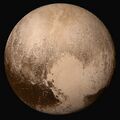Astronomy:2007 VE191
| Discovery[1] | |
|---|---|
| Discovered by | Mt. Lemmon Survey (G96) |
| Discovery date | 15 November 2007 |
| Designations | |
| 2007 VE191 | |
| Minor planet category | NEO · Apollo[2] |
| Orbital characteristics[2] | |
| Epoch 13 January 2016 (JD 2457400.5) | |
| Uncertainty parameter 7 | |
| Observation arc | 13 days (last seen 2007) |
| |{{{apsis}}}|helion}} | 3.1065 astronomical unit|AU (464.73 Gm) (Q) |
| |{{{apsis}}}|helion}} | 0.71060 AU (106.304 Gm) (q) |
| 1.9085 AU (285.51 Gm) (a) | |
| Eccentricity | 0.62767 (e) |
| Orbital period | 2.64 yr (963.04 d) |
| Mean anomaly | 12.440° (M) |
| Mean motion | 0° 22m 25.752s /day (n) |
| Inclination | 5.3847° (i) |
| Longitude of ascending node | 244.33° (Ω) |
| 254.07° (ω) | |
| Earth MOID | 0.000169707 AU (25,387.8 km) |
| Jupiter MOID | 1.99284 AU (298.125 Gm) |
| Physical characteristics | |
| Dimensions | ~63 meters[3] 50–110 meters[4] |
| Absolute magnitude (H) | 23.6[2] |
2007 VE191 is a sub-kilometer asteroid, classified as near-Earth asteroid of the Apollo group that was listed on the Sentry Risk Table.[3]
Description
It is estimated to be roughly 63 meters in diameter. In 2015 it was known to have a 1 in 63,000 chance of impacting Earth on 27 November 2015.[3] However, the nominal best-fit orbit showed that 2007 VE191 would be roughly 0.5 astronomical unit|AU (75,000,000 km; 46,000,000 mi) from Earth on 27 November 2015 with an apparent magnitude of roughly +25 in the constellation of Virgo about 50 degrees from the Sun,[5] and the same nominal orbit gave a distance of closest approach to Earth of a little under 0.4 AU a few weeks earlier. It was removed from the Sentry Risk Table on 17 September 2015,[6] but was still listed at NEODyS with odds of 1 in 3 million for 27 November 2015 during the approach window.[7]
2007 VE191 was discovered on 15 November 2007 by the Mount Lemmon Survey at an apparent magnitude of 20 using a 1.5-meter (59 in) reflecting telescope.[1] On 28 November 2007, it passed 0.0128 astronomical unit|AU (1,910,000 km; 1,190,000 mi) from Earth.[8] 2007 VE191 has an observation arc of 13 days with an uncertainty parameter of 7, which means its orbit is poorly constrained.[2] 2007 VE191 was last observed on 28 November 2007.[2] By 1 December 2007, the asteroid had faded to below magnitude 25.[9]
With an absolute magnitude of 23.6,[2] 2007 VE191 is about 50–110 meters in diameter.[4]
References
- ↑ 1.0 1.1 "MPEC 2007-W05 : 2007 VE191". IAU Minor Planet Center. 2007-11-16. http://www.minorplanetcenter.org/mpec/K07/K07W05.html. Retrieved 2014-12-15. (K07VJ1E)
- ↑ 2.0 2.1 2.2 2.3 2.4 2.5 "JPL Small-Body Database Browser: (2007 VE191)". Jet Propulsion Laboratory. http://ssd.jpl.nasa.gov/sbdb.cgi?sstr=2007VE191. Retrieved 30 March 2016.
- ↑ 3.0 3.1 3.2 "Earth Impact Risk Summary: 2007 VE191". NASA/JPL Near-Earth Object Program Office. Archived from the original on September 5, 2015. https://web.archive.org/web/20150905192052/http://neo.jpl.nasa.gov/risk/2007ve191.html. Retrieved 2014-12-15. (PS=–2.47)
- ↑ 4.0 4.1 "Absolute Magnitude (H)". NASA/JPL. http://neo.jpl.nasa.gov/glossary/h.html. Retrieved 2014-12-15.
- ↑ "2007VE191 Ephemerides for 1 September 2015 through 10 December 2015". NEODyS (Near Earth Objects – Dynamic Site). http://newton.spacedys.com/neodys/index.php?pc=1.1.3.1&n=2007VE191&oc=500&y0=2015&m0=9&d0=1&h0=0&mi0=0&y1=2015&m1=12&d1=10&h1=0&mi1=0&ti=1.0&tiu=days. Retrieved 2014-12-15.
- ↑ "Date/Time Removed". NASA/JPL Near-Earth Object Program Office. http://neo.jpl.nasa.gov/risk/removed.html. Retrieved 2015-10-19.
- ↑ "NEODyS Impactor Table for 2007VE191". NEODyS (Near Earth Objects – Dynamic Site). http://newton.spacedys.com/neodys/index.php?pc=1.1.2&n=2007VE191. Retrieved 2015-10-19. (PS=–4.87)
- ↑ "JPL Close-Approach Data: (2007 VE191)". http://ssd.jpl.nasa.gov/sbdb.cgi?sstr=2007VE191;cad=1#cad. Retrieved 2014-12-15.
- ↑ "2007VE191 Ephemerides for 1 October 2007 through 4 December 2007". NEODyS (Near Earth Objects – Dynamic Site). http://newton.spacedys.com/neodys/index.php?pc=1.1.3.1&n=2007VE191&oc=500&y0=2007&m0=10&d0=1&h0=0&mi0=0&y1=2007&m1=12&d1=4&h1=0&mi1=0&ti=1.0&tiu=days. Retrieved 2014-12-15.
External links
- 2007 VE191 at NeoDyS-2, Near Earth Objects—Dynamic Site
- Ephemeris · Obs prediction · Orbital info · MOID · Proper elements · Obs info · Close · Physical info · NEOCC
- 2007 VE191 at ESA–space situational awareness
- 2007 VE191 at the JPL Small-Body Database
 |




